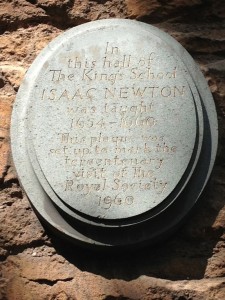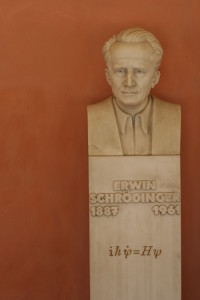Posted by Roberta Grimes • February 17, 2015 • 4 Comments
Afterlife Research, Quantum Physics, Understanding Reality
To be a physicist in the early twenty-first century looks like the most frustrating job in the universe. I say this because being even a devoted physics  groupie reading popular-science versions of what physicists are up to now feels mind-shriveling. I will give you some quick examples from the recent press:
groupie reading popular-science versions of what physicists are up to now feels mind-shriveling. I will give you some quick examples from the recent press:
Apparently the Big Bang, now thoroughly engrained in our minds as the way the universe started, isn’t such a sure thing anymore. Perhaps the universe instead is in a steady state. To quote a summary of a recent paper on phys.org: “In physical terms, the (steady state) model describes the universe as being filled with a quantum fluid. The scientists propose that this fluid might be composed of gravitons—hypothetical massless particles that mediate the force of gravity. If they exist, gravitons are thought to play a key role in a theory of quantum gravity.” (My emphasis.)
Time is one of the few things that everyone on earth experiences, but for physicists it is still a mystery. To quote a recent puzzling article in my beloved Scientific American, “Whether through Newton’s gravitation, Maxwell’s electrodynamics, Einstein’s special and general relativity or quantum mechanics, all the equations that best describe our universe work perfectly if time flows forward or backward… Of course the world we experience is entirely different….”
Physicists are attempting to study dark matter, which is called “dark” only because it  won’t interact with photons of light. They tell us that everything that we think of as real makes up only 4-5% of the universe, while dark matter makes up 23-27%. (Apparently estimates vary.) So in an effort to study a mass which is five times the size of the known universe, physicists are looking for wimps thousands of feet beneath the surface of the earth. This time we’re reading The Wall Street Journal: “A wimp—a weakly interacting massive particle—is thought to be the stuff of dark matter, an invisible substance that makes up about a quarter of the universe but has never been seen by humans.” I have talked previously about the fact that dark matter is a candidate to be the afterlife levels of reality, and there are physicists who speculate that it might be an actual inhabited reality. But rather than investigating either of these theories, physicists are spending billions of dollars investigating the unlikely possibility that five-sixths of the matter in the universe is a fluff of particles constituting nothing.
won’t interact with photons of light. They tell us that everything that we think of as real makes up only 4-5% of the universe, while dark matter makes up 23-27%. (Apparently estimates vary.) So in an effort to study a mass which is five times the size of the known universe, physicists are looking for wimps thousands of feet beneath the surface of the earth. This time we’re reading The Wall Street Journal: “A wimp—a weakly interacting massive particle—is thought to be the stuff of dark matter, an invisible substance that makes up about a quarter of the universe but has never been seen by humans.” I have talked previously about the fact that dark matter is a candidate to be the afterlife levels of reality, and there are physicists who speculate that it might be an actual inhabited reality. But rather than investigating either of these theories, physicists are spending billions of dollars investigating the unlikely possibility that five-sixths of the matter in the universe is a fluff of particles constituting nothing.
Meanwhile, Quanta Magazine tells us that “Physicists have discovered a jewel-like geometric object that dramatically simplifies calculations of particle interactions and challenges the notion that space and time are fundamental components of reality.” Oops.
There’s more, but I can see that you are nodding off. My point is that some very big things are all at once going wrong in physics.
I have come to think that holding atheistic materialism as a core dogma has at last brought physics to a true dead-end. There simply is nothing that is both material and bigger than the size of an atom that has not already been well studied, which means that drilling down into atoms is all that physicists have left. So for universities to drop all dogmas and allow physicists to study whatever turns up would shine some much-needed light into physics.
What afterlife researchers have discovered is far more than just the fact that human  minds are eternal. We are learning a great many interesting things about each of the very issues that are puzzling and confounding physicists today. And looking at what we have to show them would at least give physicists the welcome chance to go back to sometimes studying things that can be seen with the naked eye.
minds are eternal. We are learning a great many interesting things about each of the very issues that are puzzling and confounding physicists today. And looking at what we have to show them would at least give physicists the welcome chance to go back to sometimes studying things that can be seen with the naked eye.
Let’s take the concept of time as one example of where considering the afterlife evidence might be of use to working physicists. Here is some of what afterlife researchers are learning apparently is true about time:
Physicists used to understand time a lot better than they do now. Albert Einstein said, “The only reason for time is so that everything doesn’t happen at once.” He also said, “The distinction between past, present and future is only a stubbornly persistent illusion.” He understood that time is a non-fundamental construct that operates as an arrow for convenience. The afterlife evidence helps us understand that Einstein was spectacularly right.
How might it work for universities to throw out the obsoleted dogma of atheistic materialism and allow physicists to include studying the roof in their effort to better understand why there is water on the floor?
Requiring scientists charged with understanding all of reality to study only a portion of it renders it impossible for them to do anything that is ultimately productive. If there were no non-material component to reality, then it would be legitimate for university gatekeepers to forbid physicists from being distracted into researching things that are not real. The fact is, though, that over the past nearly two hundred years we have accumulated abundant and consistent evidence that much of what is  real – perhaps most of what is real – is not material. Yet it interacts with and profoundly influences the material reality that physicists are trying without much success to understand. So might it be useful to the advancement of physics for universities to abandon their century-old dogma of adamant atheistic materialism?
real – perhaps most of what is real – is not material. Yet it interacts with and profoundly influences the material reality that physicists are trying without much success to understand. So might it be useful to the advancement of physics for universities to abandon their century-old dogma of adamant atheistic materialism?
As the saying goes, at this point it can’t hurt.
photo credit: <a href=”http://www.flickr.com/photos/39377065@N08/7704280790″>Isaac Newton, Grantham</a> via <a href=”http://photopin.com”>photopin</a> <a href=”https://creativecommons.org/licenses/by/2.0/”>(license)</a>
photo credit: <a href=”https://www.flickr.com/photos/hypermodern/7437395904/”>hypermodern</a> via <a href=”http://photopin.com”>photopin</a> <a href=”http://creativecommons.org/licenses/by/2.0/”>cc</a>
photo credit: <a href=”https://www.flickr.com/photos/fischerfotos/7408813732/”>Mark Fischer</a> via <a href=”http://photopin.com”>photopin</a> <a href=”http://creativecommons.org/licenses/by-sa/2.0/”>cc</a>
Excellent article. Hope to see more of these in the near future
Thank you for reading and commenting, Lola! I’ll keep trying to please and challenge you ;-).
Brilliant blog post, Roberta!
Great understanding of what is holding the physicists back. Why are they so afraid to look in the area of the afterlife instead of just drilling down further into the subatomic particles? Thanks for your wake up call to scientists!
Thank you for visiting and commenting, dear Pavel!